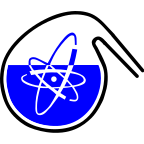Speaker
Description
Metal Organic frameworks (MOFs) are self-assemblies of metal ions and organic ligands, known for their high crystallinity and porosity. The wide range of high and accessible porosity allows them to be explored as alternatives for traditional porous materials and for many new applications. Some of them exhibit an extraordinarily huge surface area together with a high chemical stability.
One of the most studied and applied MOFs, MIL-101, was selected as the starting material for the production of chromium-51 and its enrichment based on the Szilard-Chalmers effect. After finding the most optimal synthesis conditions, several samples of MIL-101 were irradiated in the HOR reactor at Delft under different neutron fluxes and irradiation times. Upon neutron capture, the formed 51Cr atoms will get into a short-lived excited state that relaxes through the emission of prompt gamma photons. The recoil imparted on the emission of these photons is energetic enough to break chemical bonds and allow for the separation of the atom involved. Once that the different samples were irradiated the optimal conditions for the collection of the freed 51Cr were investigated. The key point for getting the best results resulted in avoiding the dissolution of chromium from the framework by selecting the right pH and extracting agents for the elution.
The use of new materials, like MOFs, with high stability and surface area may open new possibilities for isotope separation based on Szilard-Chalmers effect thanks to their widely accessible surface area, their high metal content and their high chemical (and radiation) stability.

